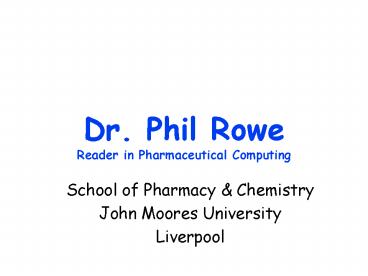Dr. Phil Rowe Reader in Pharmaceutical Computing - PowerPoint PPT Presentation
1 / 24
Title:
Dr. Phil Rowe Reader in Pharmaceutical Computing
Description:
Pharmacokinetics ADME Absorption Passive diffusion Requirements for passive diffusion Efficiency of passive diffusion Facilitated diffusion Active transport ... – PowerPoint PPT presentation
Number of Views:70
Avg rating:3.0/5.0
Title: Dr. Phil Rowe Reader in Pharmaceutical Computing
1
Dr. Phil RoweReader in Pharmaceutical Computing
- School of Pharmacy Chemistry
- John Moores University
- Liverpool
2
Pharmacokinetics lecture 1Contents ...
- What is Pharmacokinetics
- Absorption
- Distribution
3
Pharmacokinetics
- Drug movement (Greek)
- The movement of drugs
- Into
- Around
- Back out of
- the body
4
ADME
- Absorption
- Distribution
- Metabolism
- Excretion
Elimination
5
Absorption
- Three mechanisms by which drugs may cross
membranes - Passive diffusion
- Facilitated diffusion
- Active transport
- Passive diffusion MUCH more common than any of
the others.
6
Passive diffusion
DRUG
7
Requirements for passive diffusion
- Water solubility
- Lipid solubility
- Almost all drugs are sufficiently water soluble
to undergo passive diffusion, but some do lack
the necessary lipid solubility. - In practice, passive diffusion depends mainly on
lipid solubility.
8
Efficiency of passive diffusion
9
Facilitated diffusion
DRUG
Selective gateway allows entry of one group of
molecules, but excludes all others.
10
Active transport
DRUG
Structurally selective. Energy requiring Can
operate against the concentration gradient
11
Specificity
- Passive diffusion
- Non-specific. Anything lipid soluble
- Facilitated diffusion
- Active transport
- Structurally specific groups of chemicals that
fit a carrier molecule
12
Specificity
Few drugs handled by facilitated or active
transport
A molecule can only be handled by facilitated or
active transport if the body contains a suitable
carrier, so it is not surprising that very few
drugs use such mechanisms. There are some
examples. e.g. L-DOPA and gabapentin are
transported into the brain by the Large neutral
Amino Acid Transporter (LAT1)
13
P-glycoproteins
(Glycoproteins proteins with carbohydrates
attached)
Gut contents
P-gp in the apical cell membrane (facing the gut
contents). Substances are absorbed, but then
actively pumped back into the gut contents
(Efflux). ATP dependent.
Apical surface
Intestinal epithelial cell
Basolateral surface
14
Location of P-glycoproteins
OrganIntestineLiverKidneyBrain
FunctionPrevent absorptionExcretion into
bileExcretion into urinePrevent entry from
blood into brain
Generally a defensive mechanism against foreign
substances
15
Examples of substances where intestinal
absorption is opposed by P-gp mediated efflux
Celiprolol Beta blockerCyclosporin
ImmunosuppressantDexamethasone
GlucocorticoidIvermectin AnthelminticVerapami
l AntihypertensiveVincristine Cytotoxic
Wide range of drug groups and chemical structures
16
Induction and inhibition of P-gp
InductionExample - Rifampicin increase the
amount of P-gp in the intestinal epithelium.
Reduces absorption of other substances. Inhibition
Example - Large enough dose of verapamil will
saturate the P-gp. Other substances then
absorbed more easily. Has been suggested as a
means to increase absorption of problem molecules.
17
Distribution
Kidneys
Blood
Etc.
Fat
Liver
18
Factors influencing distribution of a drug
- Ability to undergo passive diffusion (Already
described) - Binding to macromolecules
- Ion trapping
- P-glycoproteins (Already described)
19
Plasma protein binding
Blood
Cell
Drug
Drug
Drug.Protein
Lipid
Total drug conc in blood greater than in cell.
20
Intra-cellular binding
Blood
Cell
Drug
Drug
Drug.Protein Lipid Nucleic
acid
Lipid
Total drug conc in blood lower than in cell.
21
Overall binding
Blood
Cell
Drug
Drug
Drug.Protein
Drug.Protein Lipid Nucleic
acid
Lipid
Balance depends upon relative binding affinity in
blood and tissues.
22
Ion trapping
Stomach (Acid)
Blood (Neutral)
Lipid
Basic drugs accumulate in acidic
environments. (Acidic drugs accumulate in basic
environments.)
23
Terms with which you should be familiar ...
Pharmacokinetics ADME Absorption
Passive diffusion Distribution
Faciliated diffusion Metabolism
Active transport Excretion
P-glycoproteins Elimination
Ion trapping
24
What you should be able to do
- Distinguish between metabolism and excretion
- Describe the characteristics of passive
diffusion, facilitated diffusion and active
transport - Predict whether a given molecule will easily
undergo passive diffusion - Describe the function of P-glycoproteins
- Identify the factors that may influence the
distribution of a given drug































